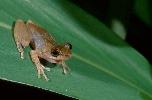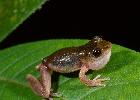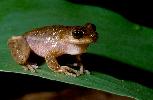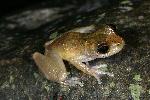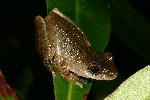Species profile—Litoria rheocola (common mistfrog)
Classification
Animalia (animals) → Amphibia (amphibians) → Hylidae (tree frogs) → Litoria rheocola (common mistfrog)
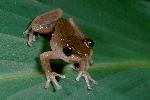
Go to Photo gallery
Sighting data
Species details
- Kingdom
- Animalia (animals)
- Class
- Amphibia (amphibians)
- Family
- Hylidae (tree frogs)
- Scientific name
- Litoria rheocola Liem, 1974
- Common name
- common mistfrog
- Type reference
- Liem, D.S. (1974). A review of the Litoria nannotis species group, and a description of a new species of Litoria from northern Queensland, Australia (Anura: Hylidae). Mem. Qd. Mus. 17: 151-168 [152 figs 1, 4C-D pl 3A].
- WildNet taxon ID
- 598
- Synonym(s)
- Dryopsophus rheocolus
Ranoidea rheocola - Alternate name(s)
- creek frog
common mist frog - Nature Conservation Act 1992 (NCA) status
- Endangered
- Conservation significant
- Yes
- Wetland status
- Wetland Indicator Species
- Endemicity
- Native
- Pest status
- Nil
- Description
- The common mistfrog is a moderate size frog with males growing to 27-36.4mm and weighing 1.2-3.3g, females 28.4-41.2mm and weighing 1.8-4.55g. The dorsal surface is dull grey or brown, with irregular darker markings. There is a distinct inverted triangle marking on the top of the head, stretching between the eyes down to the coccygeal (rump) region. An obscure darker band runs along the side of the snout, through the eye and ear to the shoulder. The skin is smooth above, with scattered small tubercles. The ventral surface is granular and white in colour. The finger and toe discs are large with the fingers moderately webbed, and the toes nearly fully webbed. The tip of the snout is bluntly pointed and the tympanum (eardrum) is small and covered by skin, though the rim may be distinct. The male nuptial pads are small, with fine dark spicules (spines). (Liem 1974; Cogger 1994).
The call is a regular, repeated long drawn single note call, a rather nasal "wreek wreek wreek" (Liem 1974; McDonald 1992).
Tadpoles have a flattened, sandy coloured body, which is darker ventrally. The tail is a very muscular, creamy yellow lightly dusted with diffuse dark pigment. The tail fins are clear, with only a few scattered dark patches. The mouth is suctorial, surrounded by marginal and submarginal papillae. There are two anterior and three posterior tooth rows. (Richards 1992). - Map
- View Map
- Distribution
- This species occured in rainforests of the Wet Tropics from Broadwater Creek to Amos Bay, north-east Queensland at elevations from 0-1180m. Significant population declines in upland populations have occurred since 1989, and the species is now largely absent from sites above 400m. (McDonald 1992; NQTFRT 2001).
- Distributional limits
- -15.7, 144.983
-18.383, 146.066 - Range derivation
- Range provided by taxon expert
- Species environment
- Aquatic & Terrestrial
- Habitat
- This species is usually found on rocks, debris and vegetation near fast-flowing streams in rainforest from 0-1180m above sea level. Tadpoles are found in swiftly flowing rainforest streams, clinging to rocks in riffles, torrents, and highly oxygenated pools. (Liem 1974; Martin & McDonald 1995).
- Behaviour
- The common mistfrog is an arboreal, nocturnal species, sheltering in refuges during the day. Males call from rocks in streams or from adjacent riparian vegetation. Females are encountered less frequently, but tend to use streamside vegetation to a greater extent. Activity levels appear to be inhibited at low temperatures. Males have been observed engaging in foot-flagging displays. (Liem 1974; Cogger et al. 1983; Richards & James 1992; Hodgkison & Hero 2002).
- Reproduction
- Calling males and gravid (pregnant) females are found throughout the year and breeding has been observed during most months. Large plain eggs measuring 1.4 - 1.8mm in diameter are deposited in a compact gelatinous clump under rocks in fast-flowing streams. (Liem 1974; Dennis & Trenerry 1984; Martin & McDonald 1995).
- Diet
- Adults are indiscriminant arthropod predators, consuming a wide range of terrestrial and aquatic invertebrates. Tadpoles graze on algae-covered rocks in fast flowing waters. (Liem 1974; Cogger et al. 1983; Hodgkison & Hero 2003).
- Predators
- Snakes (Freeman 2000).
- Parasites and pathogens
- The common mistfrog is susceptible to chytridiomycosis, a fatal disease of amphibians caused by the fungus Batrachochytrium dendrobatidis (Berger et al. 1999).
- Threatening processes
- Known : None confirmed.
Suspected : The causes of the decline remain unknown, Richards et al (1993) found no obvious evidence that drought, floods, habitat destruction or pollution by pesticides, inorganic ions or heavy metals were responsible for the population declines. Current research is examining the possibility that a disease may have caused the decline of this species. - Status notes
- L. rheocola is one of 7 species of frogs occurring in the upland rainforest streams of north-eastern Queensland which have undergone rapid and substantial population declines in the last decade (Ingram and McDonald 1993, Richards et al 1993). Declines first noted in 1989 (Richards et al. 1993), and progressed northward, effecting the northern-most site in 1994 (Ingram and McDonald 1993, McDonald and Martin 1995). Still common at lowland sites, but declined at most sites above 400m.
- Management documents
- Tyler, M.J. (1997). The Action Plan for Australian Frogs. Environment Australia, Canberra.
NQTFRT (2001). Recovery plan for the stream-dwelling rainforest frogs of the Wet Tropics biogeographic region of north-east Queensland 2000-2004. Report to Environment Australia, Canberra. QPWS, Brisbane.
AGDEH (2006). Threat Abatement Plan for infection of amphibians with chytrid fungus resulting in chytridiomycosis. Department of the Environment and Heritage, Canberra. - Management recommendations
- 1. Population assessment and monitoring.
2. Investigate the role of disease as threatening factor.
3. Translocate and reintroduce species on an adaptive management basis.
4. Continue studies on the autoecology on this species.
5. Inform and involve the public in the recovery of species.
6. Ensure frog needs are considered in relevant land management decisions.
(NQTFRT 2001). - Notes
- Contributors: Wayne E. Martin 17/07/1997; David McFarland 26/10/2007; Danielle Hansen 16/01/2009; Wayne E. Martin 27/01/2009
- References
- Berger, L., Speare, R, & Hyatt, A. (1999). Chytrid fungi and Amphibian declines: Overview, Implications and Future Directions. Pp 23-33 in A. Campbell (ed), Declines and Disappearances of Australian Frogs. Environment Australia, Canberra. 234 pp.
Cogger, H.G. (1994). Reptiles and Amphibians of Australia. Reed Books, Sydney.
Cogger, H.G., Cameron, E.E. & Cogger, H.M. (1983). Zoological Catalogue of Australia. Vol. 1 Amphibia and Reptilia. Australian Government Publishing Service, Canberra.
Dennis, A. & Trenerry, M. (1984). Observations on species diversity and habitat compartmentalization of the frogs of Mt. Lewis rainforests, North Queensland. North Queensland Naturalist 52(184), 2-9.
Freeman, A. (2000). An observation of probable predation of the Common Mist Frog (Litoria rheocola) by a Common Brown Tree Snake (Boiga irregularis). Herpetofauna, 30(1), 52.
Hodgkison, S.C. & J.-M. Hero (2002). Seasonal behaviour of Litoria nannotis, Litoria rheocola and Nyctimystes dayi in Tully Gorge, north Queensland, Australia. Pp 29-39 in R. Nattrass (ed), Frogs in the Community - Proceedings of the Brisbane Conference 13-14 Feb. 1999. Queensland Frog Society, Brisbane.
Hodgkison, S. & Hero, J-M. (2003). Seasonal, sexual and ontogenetic variations in the diet of the 'declining' frogs Litoria nannotis, Litoria rheocola and Nyctimystes dayi. Wildlife Research 30, 345-354.
Ingram, G.J. & McDonald, K.R. (1993). An update on the decline of Queensland's frogs. Pp 297-303 in D. Lunney & D. Ayers (eds), Herpetology in Australia. A diverse discipline. Royal Zoological Society of New South Wales, Mosman. 414pp.
Liem, D.S. (1974). A review of the Litoria nannotis species group and a description of a new species of Litoria from north-east Queensland, Australia. Memoirs of the Queensland Museum. 17(1), 151-168.
Martin, W.E. & McDonald, K.R. (1995). Draft Recovery Plan for the Threatened Stream-dwelling Frogs of the Wet Tropics. Queensland Department of Environment and Heritage, Brisbane.
McDonald, K.R. (1992). Distribution patterns and conservation status of north Queensland rainforest frogs. Conservation Technical Report 1. Queensland Department of Environment and Heritage, Brisbane.
McDonald, K.R., & Alford, R.A. (1999). A Review of Declining Frogs in Northern Queensland. Pp 14-22 in A. Campbell (ed), Declines and Disappearances of Australian Frogs. Environment Australia, Canberra. 234 pp.
Northern Queensland Threatened Frogs Recovery Team (NQTFRT) (2001). Recovery plan for the stream-dwelling rainforest frogs of the Wet Tropics biogeographic region of north-east Queensland 2000-2004. Report to Environment Australia, Canberra. Queensland Parks and Wildlife Service, Brisbane.
Richards, S.J. (1992). The tadpole of the Australian frog Litoria nyakalensis (Anura, Hylidae), and a key to the torrent tadpoles of northern Queensland. Alytes 10(3), 99-103.
Richards, S.J. & James, C. (1992) Foot-flagging displays of some Australian frogs. Memoirs of the Queensland Museum 132, 302.
Richards, S.J., McDonald, K.R. & Alford, R.A. (1993). Declines in populations of Australia's endemic tropical rainforest frogs. Pacific Conservation Biology 1, 66-77.
Trenerry, M.P., Laurance, W.F. & McDonald, K.R. (1994). Further evidence for the precipitous decline of endemic rainforest frogs in tropical Australia. Pacific Conservation Biology 1, 150-153. - Profile author
- Wayne E. Martin (03/02/2009)
Other resources
Data source
This profile data is sourced from the QLD Wildlife Data API using the Get species by ID function used under CC-By 4.0.
https://apps.des.qld.gov.au/species/?op=getspeciesbyid&taxonid=598.
This information is sourced from the WildNet database managed by the Queensland Department of Environment and Science.


